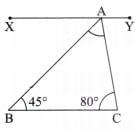Unit Test: A Tale of Three Intersecting Lines | Mathematics (Ganita Prakash) Class 7 - New NCERT PDF Download
ime: 1 hour
M.M. 30
Attempt all questions.
Question numbers 1 to 5 carry 1 mark each.
Question numbers 6 to 8 carry 2 marks each.
Question numbers 9 to 11 carry 3 marks each.
Question number 12 & 13 carry 5 marks each.
Q1: If two angles of a triangle are 35° and 85°, what is the measure of the third angle? (1 Mark)
a) 50°
b) 60°
c) 70°
d) 80°
Q2: In triangle XYZ, the exterior angle at Y is 140°, and ∠X = 65°. What is the measure of ∠Z? (1 Mark)
a) 75°
b) 80°
c) 85°
d) 90°
Q3. In a triangle DEF, if ∠D = 50° and ∠E = 60°, can a triangle be formed with these angles and a side DE of 7 cm? (1 Mark)
a) Yes, because the sum of angles is less than 180°
b) No, because the sum of angles is equal to 180°
c) No, because the sum of angles is greater than 180°
d) Yes, but only if the side length is greater than 7 cm
Q4: Which of the following sets of side lengths cannot form a triangle? (1 Mark)
a) 7 cm, 8 cm, 10 cm
b) 4 cm, 4 cm, 8 cm
c) 6 cm, 9 cm, 14 cm
d) 5 cm, 12 cm, 13 cm
Q5. If two sides of a triangle are 6 cm and 8 cm, what is the minimum integer length of the third side? (1 Mark)
a) 7 cm
b) 4 cm
c) 3 cm
d) 5 cm
Q6. In triangle XYZ, if ∠X = 90° and ∠Y = 45°, what is the measure of ∠Z? (2 Mark)
Q7. Find the exterior angle at vertex B in triangle ABC if angle A = 40 ° and angle C = 60°. (2 Mark)
Q8. In triangle XYZ, if angle X = angle Y and angle Z = 50°., what is angle X? (2 Mark)
Q9. Find the value of the unknown angle: (3 Mark)

Q10. Find the third angle of a triangle when two of the angles are 45° and 80°. (3 Mark)

Q11. In triangle LMN, if angle L = 50 degrees and angle M = 70 degrees, find the exterior angle at vertex N and determine its relationship with angles L and M. (3 Mark)
Q12. In triangle UVW, if angle U = 45 degrees and angle V = 60 degrees, find the third angle W and determine the ratio of angles U, V, and W. (5 Mark)
Q13. Construct a triangle having the side lengths 5, 5, and 8. (all units are in cm) (5 Mark)
|
41 videos|316 docs|8 tests
|
FAQs on Unit Test: A Tale of Three Intersecting Lines - Mathematics (Ganita Prakash) Class 7 - New NCERT
| 1. What are intersecting lines and how do they relate to angles? |  |
| 2. How can we determine the angle measures formed by intersecting lines? |  |
| 3. What is the significance of parallel lines in relation to intersecting lines? |  |
| 4. How do intersecting lines apply in real-life scenarios? |  |
| 5. What are some common mistakes students make when working with intersecting lines? |  |
















